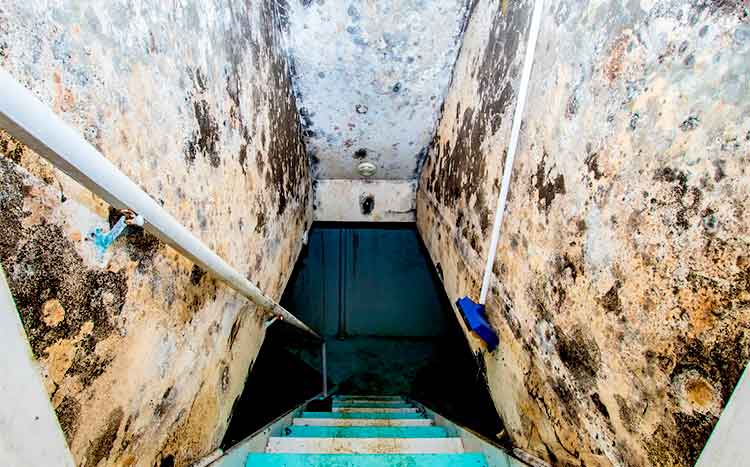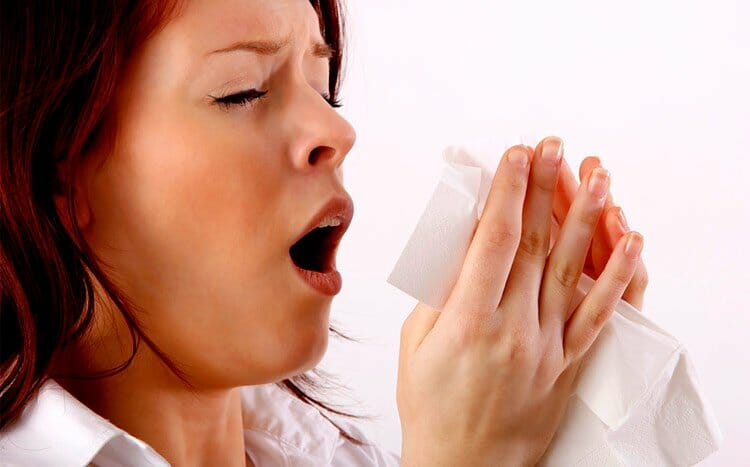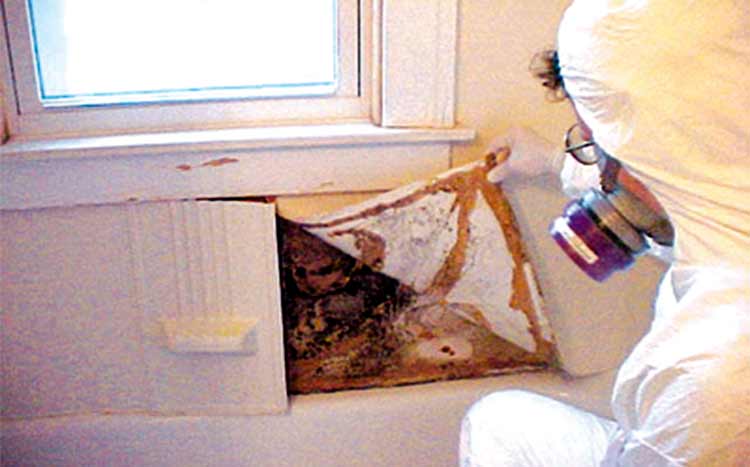Basements frequently face mold problems because their cool, dim, and damp environment creates ideal conditions for mold to thrive.
Mold in basements can find its way into your home through vents and other means and make you sick. Any mold exposure can cause coughing, wheezing, eye/skin irritation, nasal stuffiness, and throat irritation. People with allergies like asthma may develop severe reactions. Prolonged exposure to mold may lead to serious health issues.
Mold in basements should be remediated as soon as it is discovered by a professional service.
What does mold poisoning feel like?
Not all mold is poisonous, but that does not mean you should put your guard down. Some mold species are toxigenic, meaning they produce mycotoxins. Mycotoxins cause mold poisoning also called mycotoxicosis. Mold poisoning affects the upper respiratory system and leads to coughing, wheezing, and headaches.
This condition can be fatal for people with severe allergies, breathing problems, or impaired immune systems.
The symptoms of mold sickness
The common symptoms due to short-term mold exposure include:
- Sneezing
- Watery eyes
- Runny or stuffy nose
- Headache
- Itchy eyes
- Itchy skin
- Sore throat
- Skin redness and irritation
Mold allergies or sicknesses range from mild to severe and vary from one person to another. These symptoms may occur during damp weather or when you are exposed to indoor or outdoor spaces with high concentrations of the fungus.
What are the symptoms of long-term mold exposure?
People that have been exposed to mold for a long time develop severe and longer-lasting symptoms. The common symptoms include:
- Nose bleeds
- Constant headaches
- Constant fatigue
- Nausea
- Diarrhea
- Breathing problems
- Coughing blood
- Vomiting
- Weight loss
- Short-term memory loss
- Severe asthma attacks
- Muscle and joint pain
- Chronic bronchitis
As mentioned earlier, there are numerous species of mold that cause different reactions from person to person. Once your house becomes exposed, you should contact a mold remediation officer immediately. Also, see a doctor as soon as you experience the first symptoms of mold sickness.
High levels of mold exposure can cause brain damage, blindness. Cancer, long-term memory loss, bleeding lungs, and even death. To protect yourself from health risks and potential long-term side effects, repair water leaks immediately and flood-proof your house.

How to know if mold is making you sick?
Once you start developing mold exposure symptoms such as headaches, sore throat, coughing, runny nose, sneezing, fatigue, and watery eyes, among others, know that mold is making you sick. If you have a severe mold allergy, the reactions can be more severe.
An area infested by mold develops a damp or earthy smell. The smell is caused by volatile organic compounds released by mold as it grows. The dampness affects the quality of the air, making it stuffy and unpleasant.
How can mold make you sick?
The tiny mold spores cause many health problems, especially for people with allergies, respiratory issues, or compromised immune systems. Different mold species can affect your health through three main mechanisms:
- Generating harmful immune responses such as hypersensitivity pneumonitis or allergy
- Direct infection by the fungus
- Mold by-products cause toxic-irritant effects
Even if small amounts of mold may not harm you, you should still protect yourself from exposure. This is because all species of mold are not safe when inhaled. More so, you may risk severe infections and breathing problems if you do not eradicate the mold fast.

How long does it take for mold to affect your health?
Mold affects your health as soon as it invades your home. The spores fill the air quickly and spread throughout the house. Your health is in danger every hour as the mold spores continue spreading.
Once your house becomes exposed to moisture from leaks or floods, spores can start to form colonies within 24-48 hours. However, their growth rate depends on the amount of moisture, temperature, and type of surface. Mold becomes visible after about three weeks. At this time, the air around the affected areas becomes stuffy.
Since the spores will still be in the air, you may start to develop mild symptoms during the early stages of mold infestation. If you fail to eliminate the fungus early, it will spread and affect a larger area. This will put your health at risk, and you will develop worse mold sickness symptoms.
How long does it take to detox from mold?
It can take several months to detox mold from your body completely. This, however, depends on the level of exposure. People who have been exposed to large amounts of mold can take longer to detox. Also, different people may respond differently to the detox, so the period may be different.
You will start feeling better as mold levels start decreasing in your body. Sauna or exercise are also excellent ways to reduce the mold levels in your body. You can also reduce the mycotoxin levels in the atmosphere using air filters.
Ensure you eliminate mold from your home once you start the detox. This is to prevent reinfection and protect your home from significant mold damage. It is not safe to remove mold yourself because you may heighten the exposure.
How do I know if my cough is from mold?
The signs and symptoms of mold allergy are similar to other types of allergies common in the upper respiratory system. If your home is exposed to mold, you may experience allergic reactions such as sneezing, stuffy nose, wheezing, and coughing. The symptoms may linger, unlike those of the common flu because of the continuous exposure.
You may, however, not be aware of the mold, especially if it is in hidden parts of the home. If you suspect your home has mold, undertake remediation measures immediately.
Mold exposure treatment
Besides the signs and symptoms, your physician can conduct a skin prick or blood test to check for identifiable allergies. The best way to treat mold allergy is to avoid exposure to the triggers. However, it may not be possible to avoid mold. Some of the medications that can reduce your symptoms include:
- Nasal corticosteroids: these are nasal sprays that help in preventing and treating inflammation caused by allergies.
- Antihistamines: these block histamine released by the immune system when you develop an allergy. They help with sneezing, runny nose, and itching.
- Oral decongestants: they are effective, but they can raise blood pressure. They are, thus, not ideal for people with hypertension.
- Decongestant nasal sprays: these effectively ease congestion in the nose. However, you should not use them for more than three days because congestion may reappear with worse symptoms once you stop using the medication.
- Montelukast: this medication blocks leukotriene’s action. It is highly effective in asthma treatment and mold allergy.
FAQ's
What are the signs of mold in your house?
Mold develops within 24 or 48 hours after water damage. Once your home becomes infested, it starts smelling damp. Also, you will spot dark patches in the affected areas. Some molds may appear thread-like or white. Prolonged exposure to moisture from floods or water leaks leads to mold growth.
These naturally occurring fungal growths are found anywhere with plenty of moisture and oxygen. However, they seek decaying matter to feed on and warmer climates to accelerate their growth. Therefore, homes become a great target during summer.
How to test your house for mold?
You can easily spot most mold, but hidden and small growths may be hard to note. If you suspect your home may be infested, you can hire a mold remediation expert to test and eliminate it. You can also buy a test kit from a local home improvement store and do the test yourself.
Alternatively, you can test the mold using a diluted bleach solution (1 part bleach and 16 parts water). Dip a swab or cloth into the solution, then dab it on the surface. If the area lightens up, it may indicate the presence of mold.
Can mold grow in your lungs?
Yes, mold spores can grow in your lungs. Chronic diseases like tuberculosis, autoimmune conditions, cancer, trauma, or pulmonary embolism can cause lung cavities. The fungus’ fibers combine with white blood cells to form lumps called mycetoma or aspergilloma. Aspergillosis is a mold infection caused by a type of mold called Aspergillosis fumigatus. This infection is prevalent in people with a weak immune system or chronic lung problems.
Can a damp basement cause health problems?
Yes, a damp basement can cause health problems if the floors or walls are exposed to moisture. Mold thrives in damp areas, and it can cause allergies and serious reactions. If left unchecked, it can move upstairs and affect the rest of your house.
Mold can cause serious health issues, so it should be eliminated as soon as possible. It spreads quickly and can cause major damage, which may be costly to remediate. Besides your health, mold may also negatively affect your home’s resale value.







